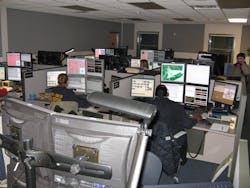Continuity of Operation (COOP) is an important concept in business and a keystone of the fire service. In order to fulfill our commitment to the community, we must be able to respond and function during almost any imaginable scenario. To this end, we maintain reserve engines for use should a primary piece malfunction, we create plans that reallocate our resources in the event of severe weather, and we ready ourselves in case of cascading failures in our strategy and tactics. One particular fire service function that is especially sensitive to downtime is emergency communications. The public rightfully expects that each and every 9-1-1 call be answered promptly and efficiently, and that appropriate apparatus be dispatched without delay.
A number of best practices and regulations have been developed that apply to dispatching, and significant attention is paid to ensure that Public Safety Answering Points (PSAPs) are provided with backup power and other redundant systems to ensure their survivability. NFPA 1221: Standard for the Installation, Maintenance, and Use of Emergency Services Communications Systems speaks directly to the requirements necessary to ensure a secure and reliable communications center. But what happens when, in spite of all precautions, your facility fails? How do you manage a full-scale evacuation?
Critical questions
Evacuation of the dispatch center can be triggered by a number of factors. Some situations can build slowly, while others may be emergent in nature and require immediate action. Both possibilities must be addressed through preplanning. Potential triggers include fire, flood, hazardous materials release, tornado, hurricane, hostile action, structural instability, bomb threat, telephone outage, and complete loss of power, technical systems or functionality, such as with a heating, ventilation and air conditioning (HVAC) unit.
These conditions, and any others that apply, become part of your evacuation plan. Further definition of some items is often required. For example, do you automatically vacate on the threat of an explosive device or are other conditions attached? These decisions tend to be local choices, and this guidance needs to be formalized. The authority to evacuate must also be clarified in advance. There are likely a number of positions within upper management to whom this responsibility will fall, but don’t forget to empower the dispatch staff as well. Where a direct threat to life safety exists, securing offsite permission should not be necessary.
The next question becomes where to relocate? Certain states, like North Carolina, require that 9-1-1 centers file a formal backup plan that clearly identifies this destination. There are, however, a number of options to explore. Some jurisdictions maintain a duplicate facility strictly for such contingencies. Others may utilize locations whose primary purpose is to serve emergency management or training roles, but that can be quickly switched to dispatch duties. Many bypass the brick-and-mortar approach in favor of a mobile command post or hosting by neighboring agencies.
The most immediate action to be taken in an evacuation is to ensure that inbound telephone calls continue to be answered. This means that a transfer—whether temporary or long term—to a staffed facility must be accomplished immediately. Where 9-1-1 lines and other critical circuits are redirected, a password-protected request is often required by the local service provider. Arrangements should be made to have these instructions on file at another 24-hour emergency location, just in case. These and other critical procedures should also be available as a “take-along” for on-duty supervisors.
Dispatching calls
But getting the call answered is just one part of the equation; getting it dispatched is another. With regional radio networks this is not always an issue, as a number of departments may share frequencies or operate from the same trunked system. The advent of RoIP (Radio over Internet Protocol) also allows for control of broadcast resources over digital circuits where so equipped. Mutual-aid channels are another means for relaying messages from one agency to another, but remember that these may be in heavy use during natural disasters and weather emergencies. Calls can be relayed by any means available from remote locations to the host department; however, these means and methods must be identified before that fact.
Another consideration in planning involves evacuations that cover not only the dispatch center, but also the entire community. If you protect a coastal area, for example, there may be the potential for the populace of several towns and even counties to be moved inland. Neighboring facilities that would normally be a good option for hosting your operations may no longer be functional.
What, if any, materials must be physically removed from the primary dispatch center during relocation is dependent upon the robustness of your alternate. If you relocate to a mirror image site, then moving the staff will be the largest concern. Take any sign-in sheets that may be in effect, and follow the plan for transfer of personnel. Does this involve the use of personal vehicles or is a municipal bus or van available? Is a law enforcement escort required? These are things that must be determined in advance. If your destination does not provide adequate support, then many things may need to be moved. This could include items such as Emergency Fire Dispatch (EFD) and Emergency Medical Dispatch (EMD) protocol cards, portable radios, laptop computers and much more. Some agencies utilize a checklist form of standard operating procedures (SOPs) to effectively manage evacuations, and provide rolling suitcases as a means of transport. The National Emergency Number Association (NENA) has an excellent document to use as a template available at http://tinyurl.com/PSAP-evac. Of course, if your backup center is lacking, you must prepare to operate without supplies from your primary as a worst-case scenario, because certain situations dictate that seconds are critical.
Even if your secondary site is fairly complete, there can still be deficiencies that impact service. For example, are all technologies supported when in backup mode? Do your Mobile Data Terminals (MDTs), paging, and station alerting continue to function at full capacity, or will any or all of these services be restricted or lost? And what of scenarios where a technical failure, power outage or fire was cause for the relocation of operations? Is there any critical equipment located at your primary site that is not replicated elsewhere? If so, you will need to work around this unfortunate fact.
Start a plan
Like any good plan, dispatch evacuation procedures need to be regularly exercised. When doing so, be sure that all personnel have a chance to participate. Depending on your staffing plan, this may take two or more days. It’s also good to periodically conduct the drill over an extended period of time. From personal experience, I’ve identified problems during longer tests that never surfaced during the regular 48-hour drills. Consider your staff in live events as well. From notifying the “next shift” to report to a new location, to securing parking, meals and other necessities, there is much to think about and do.
Planning for PSAP evacuations, while not in the forefront of daily concerns, rates high on the list of critical issues. Without a concise, coherent and coordinated set of policies, what is already a major impediment to operations can quickly turn into a catastrophic failure.
About the Author

Barry Furey
BARRY FUREY, who is a Firehouse Contributing Editor, provides consulting and training services in emergency communications. He is the former director of the Raleigh-Wake Emergency Communications Center in North Carolina. During his 50-year public safety career, he has managed 9-1-1 centers and served as a volunteer fire officer in three other states. In 2005, Furey received a life membership in the Association of Public-Safety Communications Officials (APCO) International for his continued work in emergency communications. Furey was inducted into the Firehouse Hall of Fame in 2017.
